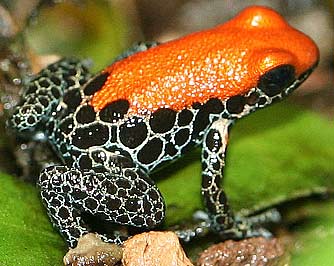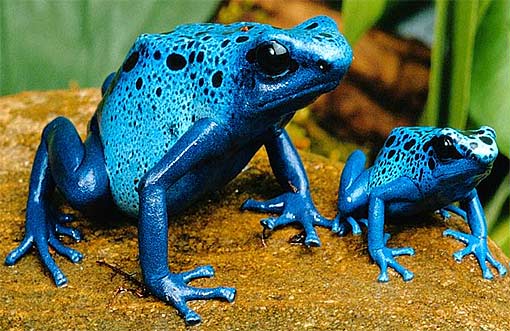Poison Dart Frogs – The Most Poisonous of All Animals

This tiny frog uses toxic chemical secretions as a defense system. It is technically poisonous not venomous. Venomous animals inject toxins via a weapon like a tail, fang, spine, spur or tooth. The toxin is only effective when the frog is bitten or otherwise attacked and since the frog doesn’t want to be harmed, they come in all kinds of vibrant color patterns as a warning to would be attackers. There are about 175 different related species, some are poisonous and a few are extremely poisonous.

In fact, this most poisonous frogs is possibly the most poisonous animal in the world. The toxin is in its skin – you can even die just by touching it – and there is enough in the skin of one frog to kill up to 100 people. The golden poison dart frog specifically is the most poisonous and its body is a vibrant yellow or orange to warn predators of extreme danger, as if to say “Do you see me. I am a very bright yellow all over my body. This is a really serious warning to you predators. Do not mess with me.” The frog has been known to science since 1978, inhabiting just one area in Columbia. The Choco tribe in the area has known about it for generations, borrowing a little of its chemical toxic secretions to poison their blowgun darts and kill other animals, such as monkeys, in seconds.
The poison dart frogs most likely get their batrachotoxin (frog poison) from other animals, probably ants or maybe beetles, which in turn get it from plant sources. It is a nuerotoxin and cardiotoxin as much as ten times more toxic than the tetrodotoxin of the pufferfishes with some possible medicinal uses. Interestingly, captive bread frogs never become toxic, this is presumably because they aren’t fed the right diet of their favorite toxic insects. The frog is active during the day, since it has few predators. However, nature never rests or excepts defeat and there is one snake that has become immune to the toxin.
Surprisingly, birds have been discovered in New Guinea with the same toxin in their skin and fathers. Most likely they collect the chemicals from the ants or beetles that they eat, similar to the new world ants, which also contain the same chemical voodoo as the South American ones. Mantella frogs of Madagascar also employ the same defensive strategy of secreting toxins and wearing bright warning colors.
